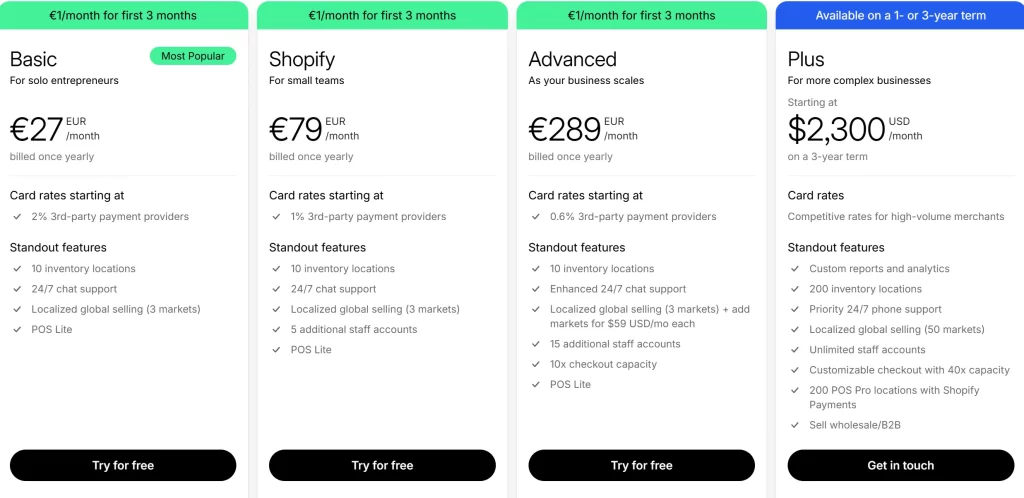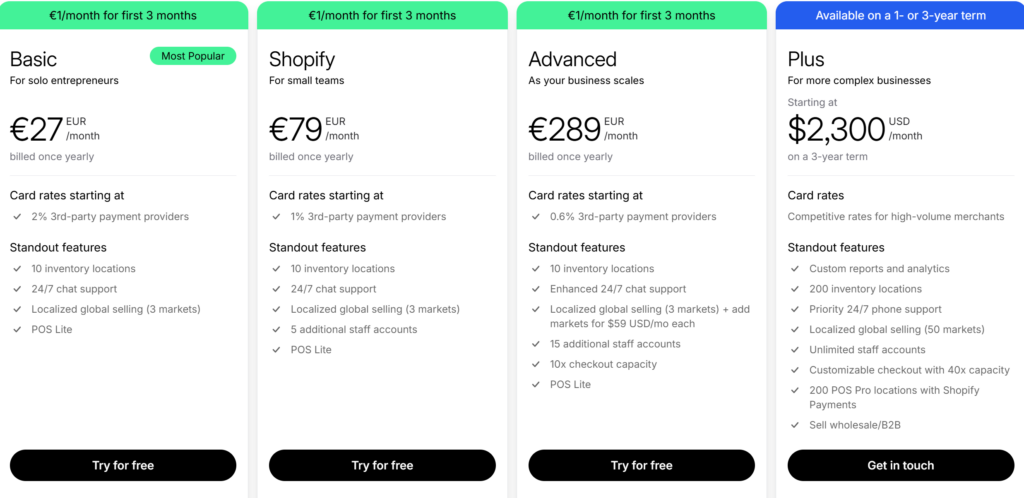Before launching your Shopify store, it is essential to understand the pricing structure and any hidden costs associated with it.
Hey there, future e-commerce superstars! Today, we’re diving into the world of Shopify pricing. Whether you’re just starting out or looking to scale your online empire, understanding these pricing models is crucial. So, let’s break it down and find the perfect plan for your business!

First things first, Shopify offers four main pricing tiers:
1. Basic Shopify
2. Shopify
3. Advanced Shopify
4. Shopify Plus
Ideal for: Solo entrepreneurs or small businesses just starting their e-commerce journey
Ideal for: Growing businesses ready to scale up their operations.
Ideal for: High-volume sellers and larger businesses with complex needs.
Ideal for: Large enterprises and high-growth companies with specific requirements.

1. Staff Accounts: As your business grows, you’ll need more hands on deck. The higher-tier plans accommodate larger teams.
2. Transaction Fees: They decrease as you move up the tiers. If you’re processing a high volume of sales, Advanced Shopify could save you money in the long run.
3. Features: While all plans offer core e-commerce functionality, higher tiers provide more advanced tools for reporting, automation, and customization.
4. Support: All plans offer 24/7 support, but Shopify Plus provides dedicated support for enterprise-level needs.
Remember, the best plan for you depends on your specific needs, budget, and growth projections. Start with what fits your current situation, but don’t be afraid to upgrade as your business expands
Now, let’s talk about transaction fees. This is where things get interesting. If you use Shopify Payments, you’ll avoid additional transaction fees.
However, if you opt for external payment gateways, you’re looking at:
– 2% for Basic Shopify
– 1% for Shopify
– 0.6% for Advanced Shopify
These percentages might seem small, but they can add up quickly, especially as your sales volume increases.
Here’s where we uncover those hidden costs that can catch you off guard:
1. App Subscriptions: While Shopify offers a robust platform out of the box, many stores require additional
functionality through apps. These can range from $5 to $250+ per month.
2. Theme Costs: A premium theme can set you back anywhere from $100 to $350, a one-time cost that can
significantly impact your initial setup expenses.
3. Custom Development: Need specific features? Custom development can easily run into thousands of dollars.
4. Credit Card Rates: Even with Shopify Payments, you’re still paying credit card processing fees, which vary base on your plan and whether the transaction is online or in-person.
5. Shipping Costs: While not unique to Shopify, shipping costs can eat into your profits if not carefully managed.
Let’s put this all together with a hypothetical example:
Imagine you’re on the Shopify plan at $79/month, selling $20,000 worth of products monthly. You’re using Shopify Payments, have three essential apps totaling $50/month, and you invested in a premium theme for $180.
Shopify Plan: $79
App Subscriptions: $50
Credit Card Fees (avg. 2.9% + 30¢ per transaction): ~$580
Theme Cost (amortized over a year): $15
That’s roughly $724 in monthly fees, not including any shipping or marketing costs.
share this article :

Selecting the optimal paid advertising platform is crucial for maximizing your e-commerce venture's potential and can significantly impact your...

Imagine your email as a package traveling through a complex network of post offices. How do we ensure it's not tampered with...
Before launching your Shopify store, it is essential to understand the pricing structure and any hidden costs associated with it.
Hey there, future e-commerce superstars! Today, we’re diving into the world of Shopify pricing. Whether you’re just starting out or looking to scale your online empire, understanding these pricing models is crucial. So, let’s break it down and find the perfect plan for your business!

First things first, Shopify offers four main pricing tiers:
1. Basic Shopify
2. Shopify
3. Advanced Shopify
4. Shopify Plus
Ideal for: Solo entrepreneurs or small businesses just starting their e-commerce journey
Ideal for: Growing businesses ready to scale up their operations.
Ideal for: High-volume sellers and larger businesses with complex needs.
Ideal for: Large enterprises and high-growth companies with specific requirements.

1. Staff Accounts: As your business grows, you’ll need more hands on deck. The higher-tier plans accommodate larger teams.
2. Transaction Fees: They decrease as you move up the tiers. If you’re processing a high volume of sales, Advanced Shopify could save you money in the long run.
3. Features: While all plans offer core e-commerce functionality, higher tiers provide more advanced tools for reporting, automation, and customization.
4. Support: All plans offer 24/7 support, but Shopify Plus provides dedicated support for enterprise-level needs.
Remember, the best plan for you depends on your specific needs, budget, and growth projections. Start with what fits your current situation, but don’t be afraid to upgrade as your business expands
Now, let’s talk about transaction fees. This is where things get interesting. If you use Shopify Payments, you’ll avoid additional transaction fees.
However, if you opt for external payment gateways, you’re looking at:
– 2% for Basic Shopify
– 1% for Shopify
– 0.6% for Advanced Shopify
These percentages might seem small, but they can add up quickly, especially as your sales volume increases.
Here’s where we uncover those hidden costs that can catch you off guard:
1. App Subscriptions: While Shopify offers a robust platform out of the box, many stores require additional
functionality through apps. These can range from $5 to $250+ per month.
2. Theme Costs: A premium theme can set you back anywhere from $100 to $350, a one-time cost that can
significantly impact your initial setup expenses.
3. Custom Development: Need specific features? Custom development can easily run into thousands of dollars.
4. Credit Card Rates: Even with Shopify Payments, you’re still paying credit card processing fees, which vary base on your plan and whether the transaction is online or in-person.
5. Shipping Costs: While not unique to Shopify, shipping costs can eat into your profits if not carefully managed.
Let’s put this all together with a hypothetical example:
Imagine you’re on the Shopify plan at $79/month, selling $20,000 worth of products monthly. You’re using Shopify Payments, have three essential apps totaling $50/month, and you invested in a premium theme for $180.
Shopify Plan: $79
App Subscriptions: $50
Credit Card Fees (avg. 2.9% + 30¢ per transaction): ~$580
Theme Cost (amortized over a year): $15
That’s roughly $724 in monthly fees, not including any shipping or marketing costs.
share this article :

Selecting the optimal paid advertising platform is crucial for maximizing your e-commerce venture's potential and can significantly impact your...

Imagine your email as a package traveling through a complex network of post offices. How do we ensure it's not tampered with...